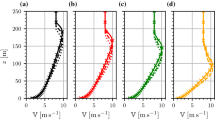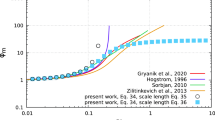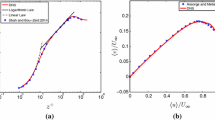Abstract
We advance our prior energy- and flux-budget (EFB) turbulence closure model for stably stratified atmospheric flow and extend it to account for an additional vertical flux of momentum and additional productions of turbulent kinetic energy (TKE), turbulent potential energy (TPE) and turbulent flux of potential temperature due to large-scale internal gravity waves (IGW). For the stationary, homogeneous regime, the first version of the EFB model disregarding large-scale IGW yielded universal dependencies of the flux Richardson number, turbulent Prandtl number, energy ratios, and normalised vertical fluxes of momentum and heat on the gradient Richardson number, Ri. Due to the large-scale IGW, these dependencies lose their universality. The maximal value of the flux Richardson number (universal constant ≈0.2–0.25 in the no-IGW regime) becomes strongly variable. In the vertically homogeneous stratification, it increases with increasing wave energy and can even exceed 1. For heterogeneous stratification, when internal gravity waves propagate towards stronger stratification, the maximal flux Richardson number decreases with increasing wave energy, reaches zero and then becomes negative. In other words, the vertical flux of potential temperature becomes counter-gradient. Internal gravity waves also reduce the anisotropy of turbulence: in contrast to the mean wind shear, which generates only horizontal TKE, internal gravity waves generate both horizontal and vertical TKE. Internal gravity waves also increase the share of TPE in the turbulent total energy (TTE = TKE + TPE). A well-known effect of internal gravity waves is their direct contribution to the vertical transport of momentum. Depending on the direction (downward or upward), internal gravity waves either strengthen or weaken the total vertical flux of momentum. Predictions from the proposed model are consistent with available data from atmospheric and laboratory experiments, direct numerical simulations and large-eddy simulations.
Similar content being viewed by others
Abbreviations
- A z = E z /E K :
-
Ratio of the vertical turbulent kinetic energy, E z , to TKE, E K
- E = E K + E P :
-
Total turbulent energy (TTE)
- \({E_K =\frac{1}{2}\left\langle {u_i u_i }\right\rangle}\) :
-
Turbulent kinetic energy (TKE)
- E i :
-
Vertical (i = z) and horizontal (i = x, y) components of TKE
- \({E_\theta =\frac{1}{2}\left\langle {\theta ^{2}}\right\rangle}\) :
-
“Energy” of potential temperature fluctuations
- E P :
-
Turbulent potential energy (TPE) given by Eq. 25
- E W :
-
IGW kinetic energy given by Eq. 16
- \({\hat{E}_z}\) :
-
Dimensionless vertical TKE given by Eq. 70
- e :
-
Vertical unit vector
- e W (k):
-
Energy spectrum of the ensemble of internal gravity waves (IGW) given by Eq. 17
- \({F_i =\;\left\langle {u_i \;\theta }\right\rangle}\) :
-
Potential-temperature flux
- F z :
-
Vertical component of the potential-temperature flux
- \({F_{i}^{W}}\) :
-
Instantaneous potential-temperature flux caused by the IGW–turbulence interaction given by Eq. 42
- \({F_i^{WW}}\) :
-
Potential-temperature flux caused by IGW averaged over the period of IGW, given by Eq. 21
- \({F_\theta ^W}\) :
-
Scale of the IGW contribution turbulent flux of potential temperature given by Eq. 57
- \({\hat{E}_z}\) :
-
Dimensionless vertical TKE given by Eq. 70
- \({f=2 \Omega\sin \varphi}\) :
-
Coriolis parameter
- G :
-
“Wave-energy parameter” proportional to the normalized IGW kinetic energy, E W , given by Eq. 50
- g :
-
Acceleration due to gravity
- H :
-
External height scale
- K M :
-
Eddy viscosity given by Eq. 79
- K H :
-
Eddy conductivity given by Eq. 80
- k :
-
Wave vector
- k α = (k x , k y ):
-
Horizontal wave vector with \({k_h =\pm \sqrt{k_x^2 +k_y^2 }}\)
- \({k=\sqrt{k_z^2 +k_h^2 }}\) :
-
Total wavenumber
- L :
-
Obukhov length scale given by Eq. 5
- L W :
-
Minimal wave length of the large-scale IGW
- l z :
-
Vertical turbulent length scale
- N :
-
Mean-flow Brunt–Väisälä frequency
- P :
-
Pressure
- P 0 :
-
Reference value of P
- P W :
-
Pressure variation caused by IGW
- p :
-
Pressure fluctuation caused by turbulence
- Pr = ν/κ:
-
Prandtl number
- Pr T :
-
Turbulent Prandtl number given by Eq. 2
- Q :
-
Dimensionless lapse rate given by Eq. 44
- Q ij :
-
Correlations between the pressure and the velocity-shear fluctuations, given by Eqs. 34 and 63
- r :
-
Radius-vector of the centre of the wave packet
- Ri :
-
Gradient Richardson number, Eq. 1
- Ri f :
-
Flux Richardson number, Eq. 4
- \({{Ri}_f^\infty}\) :
-
Limiting value of Ri f in the flow without IGW (universal constant in the homogeneous sheared flow)
- \({{Ri}_f^{\max }}\) :
-
Limiting value of Ri f in the presence of IGW (depends on the G and Q)
- S = |∂U/∂z|:
-
Vertical shear of the horizontal mean wind
- T :
-
Absolute temperature
- T 0 :
-
Reference value of the absolute temperature
- \({t_T =l_z E_z^{-1/2}}\) :
-
Turbulent dissipation time scale
- t τ :
-
Effective dissipation time scale
- \({{\bf V}^{W}=\left({V_1^W, V_2^W, V_3^W}\right)}\) :
-
IGW velocity given by Eqs. 9–10
- \({V_0^W ({\bf k})}\) :
-
IGW amplitude
- U = (U1, U2, U3):
-
Mean wind velocity
- u :
-
Turbulent velocity
- Z 0 :
-
Height of the IGW source
- β = g/T0:
-
Buoyancy parameter
- γ = c p /c v :
-
Ratio of specific heats
- \({\varepsilon_K,\varepsilon_\theta, \varepsilon_i^{(F)}}\) and \({\varepsilon_{ij}^{(\tau)}}\):
-
Dissipation rates for \({E_K, E_\theta, F_i^{(F)}}\) and τ ij
- εα3(eff)(α = 1, 2):
-
Effective dissipation rates of the vertical turbulent fluxes of momentum
- κ :
-
Temperature conductivity
- μ :
-
Exponent of the energy spectrum of the ensemble of IGW
- ν :
-
Kinematic viscosity
- Φ K , Φ θ and Φ F :
-
Third-order moments representing turbulent fluxes of E K , E θ and F i
- φ :
-
Latitude
- ΠW :
-
IGW production of TKE given by Eq. 49
- \({\Pi_i^W}\) :
-
IGW production of the vertical (i = z) and horizontal (i = x, y) components of TKE given by Eqs. 52–53
- \({\Pi_\theta^W}\) :
-
IGW production of E θ given by Eq. 56
- \({\Pi_E^W =\Pi ^{W}+\Pi_\theta ^W \beta ^{2}N^{-2}}\) :
-
IGW production of TTE
- \({\Pi_F^W}\) :
-
IGW production of the flux of potential temperature given by Eq. 58
- \({\Pi_{\tau \alpha }^W}\) :
-
IGW production of the non-diagonal components of the Reynolds stresses, τ α3, given by Eq. 61
- τ ij :
-
Reynolds stresses characterising the turbulent flux of momentum
- τα3(α = 1, 2):
-
Components of the Reynolds stresses characterising vertical turbulent flux of momentum
- τ :
-
Modulus of (\({\tau_{13}, \tau_{23}}\))
- \({\tau_{ij}^W}\) :
-
Instantaneous Reynolds stresses caused by IGW, given by Eq. 41
- \({\tau_{ij}^{WW}}\) :
-
Reynolds stresses caused by IGW averaged over the period of IGW given by Eqs. 21 and 43
- ρ 0 :
-
Density
- Θ:
-
Potential temperature
- Θ W :
-
IGW potential temperature given by Eq. 11
- θ :
-
Turbulent fluctuation of potential temperature
- Ω i :
-
Earth’s rotation vector parallel to the polar axis
- ω :
-
Frequency of IGW
References
Baines PG (1995) Topographic effects in stratified flows. Cambridge University Press, New York, p 482
Banta RM, Newsom RK, Lundquist JK, Pichugina YL, Coulter RL, Mahrt L (2002) Nocturnal low-level jet characteristics over Kansas during CASES-99. Boundary-Layer Meteorol 105: 221–252
Baumert H, Peters H (2004) Turbulence closure, steady state, and collapse into waves. J Phys Oceanogr 34: 505–512
Baumert H, Peters H (2009) Turbulence closure: turbulence, waves and the wave-turbulence transition—part 1: vanishing mean shear. Ocean Sci 5: 47–58
Beer T (1974) Atmospheric waves. Wiley, New York, p 300
Bertin F, Barat J, Wilson R (1997) Energy dissipation rates, eddy diffusivity, and the Prandtl number: an in situ experimental approach and its consequences on radar estimate of turbulent parameters. Radio Sci 32: 791–804
Canuto VM, Minotti F (1993) Stratified turbulence in the atmosphere and oceans: a new sub-grid model. J Atmos Sci 50: 1925–1935
Canuto VM, Cheng Y, Howard AM, Esau IN (2008) Stably stratified flows: a model with no Ri(cr). J Atmos Sci 65: 2437–2447
Cheng Y, Canuto VM, Howard AM (2002) An improved model for the turbulent PBL. J Atmos Sci 59: 1550–1565
Chimonas G (1999) Steps, waves and turbulence in the stably stratified planetary boundary layer. Boundary-Layer Meteorol 90: 397–421
Churchill SW (2002) A reinterpretation of the turbulent Prandtl number. Ind Eng Chem Res 41: 6393–6401
Einaudi F, Finnigan JJ (1993) Wave-turbulence dynamics in the stably stratified boundary layer. J Atmos Sci 50: 1841–1864
Einaudi F, Finnigan JJ, Fua D (1984) Gravity wave turbulence interaction in the presence of a critical level. J Atmos Sci 41: 661–667
Elperin T, Kleeorin N, Rogachevskii I (1996) Isotropic and anisotropic spectra of passive scalar fluctuations in turbulent fluid flow. Phys Rev E 53: 3431–3441
Elperin T, Kleeorin N, Rogachevskii I, Zilitinkevich S (2002) Formation of large-scale semi-organized structures in turbulent convection. Phys Rev E 66: 066305-1–066305-15
Elperin T, Kleeorin N, Rogachevskii I, Zilitinkevich S (2006) Turbulence and coherent structures in geophysical convection. Boundary-layer Meteorol 119: 449–472
Esau I (2004) Simulation of Ekman boundary layers by large eddy model with dynamic mixed sub-filter closure. Environ Fluid Mech 4: 273–303
Finnigan JJ (1988) Kinetic energy transfer between internal gravity waves and turbulence. J Atmos Sci 45: 486–505
Finnigan JJ (1999) A note on wave-turbulence interaction and the possibility of scaling the very stable boundary layer. Boundary-Layer Meteorol 90: 529–539
Finnigan JJ, Einaudi F (1981) The interaction between an internal gravity wave and the planetary boundary layer. Part II: effect of the wave on the turbulence structure. Q J Roy Meteorol Soc 107: 807–832
Finnigan JJ, Einaudi F, Fua D (1984) The interaction between an internal gravity wave and turbulence in the stably-stratified nocturnal boundary layer. J Atmos Sci 41: 2409–2436
Fofonoff NP (1969) Spectral characteristics of internal waves in the ocean. Deep-Sea Res 16: 58–71
Foken T (2006) 50 years of the Monin–Obukhov similarity theory. Boundary-Layer Meteorol 119: 431–447
Fritts DC, Alexander MJ (2003) Gravity wave dynamics and effects in the middle atmosphere. Rev Geophys 41(1): 1003
Garrett C, Munk W (1979) Internal waves in the ocean. Annu Rev Fluid Mech 11: 339–369
Gossard EE, Hooke WH (1975) Waves in the atmosphere. Elsevier, New York, p 456
Jacobitz FG, Rogers MM, Ferziger JH (2005) Waves in stably stratified turbulent flow. J Turbul 6: 1–12
Jin LH, So RMC, Gatski TB (2003) Equilibrium states of turbulent homogeneous buoyant flows. J Fluid Mech 482: 207–233
Kaimal JC, Fennigan JJ (1994) Atmospheric boundary layer flows. Oxford University Press, New York, p 289
Kolmogorov AN (1941) Energy dissipation in locally isotropic turbulence. Doklady AN SSSR 32(1): 19–21
Kondo J, Kanechika O, Yasuda N (1978) Heat and momentum transfer under strong stability in the atmospheric surface layer. J Atmos Sci 35: 1012–1021
Kurbatsky AF (2000) Lectures on turbulence. Novosibirsk State University Press, Novosibirsk, p 118
L’vov VS, Rudenko O (2008) Equations of motion and conservation laws in a theory of stably stratified turbulence. Phys Scr T132: 014009-1–014009-5
L’vov VS, Pomyalov A, Procaccia I, Zilitinkevich SS (2006) Phenomenology of wall bounded Newtonian turbulence. Phys Rev E73: 016303-1–016303-13
L’vov VS, Procaccia I, Rudenko O (2008) Turbulent fluxes in stably stratified boundary layers. Phys Scr T132: 014010-1–014010-15
Mahrt L, Vickers D (2005) Boundary layer adjustment over small-scale changes of surface heat flux. Boundary-Layer Meteorol 116: 313–330
Mauritsen T, Svensson G (2007) Observations of stably stratified shear-driven atmospheric turbulence at low and high Richardson numbers. J Atmos Sci 64: 645–655
Mauritsen T, Svensson G, Zilitinkevich SS, Esau I, Enger L, Grisogono B (2007) A total turbulent energy closure model for neutrally and stably stratified atmospheric boundary layers. J Atmos Sci 64: 4117–4130
Miropolsky YZ (1981) Dynamics of internal gravity waves in the ocean. Gidrometeoizdat, Leningrad, 302 pp (translation in English published in 2006)
Moser RG, Kim J, Mansour NN (1999) Direct numerical simulation of turbulent channel flow up to Re = 590. Phys Fluids 11: 943–945
Nappo CJ (2002) An introduction to atmospheric gravity waves. Academic Press, London, p 276
Ohya Y (2001) Wind-tunnel study of atmospheric stable boundary layers over a rough surface. Boundary-Layer Meteorol 98: 57–82
Pochapsky H (1972) Internal waves and turbulence in the deep ocean. J Phys Oceanogr 2: 96–103
Polzin K (2004a) A heuristic description of internal wave dynamics. J Phys Oceanogr 34: 214–230
Polzin K (2004b) Idealized solutions for the energy balance of the fine scale internal wave field. J Phys Oceanogr 34: 231–246
Poulos GS, Blumen W, Fritts DC, Lundquist JK, Sun J, Burns SP, Nappo C, Banta R, Newsom R, Cuxart J, Terradellas E, Balsley B, Jensen M (2002) CASES-99: a comprehensive investigation of the stable nocturnal boundary layer. Bull Am Meteorol Soc 83: 555–581
Rehmann CR, Koseff JR (2004) Mean potential energy change in stratified grid turbulence. Dyn Atmos Oceans 37: 271–294
Rotta JC (1951) Statistische theorie nichthomogener turbulenz. Z Phys 129: 547–572
Staquet C, Sommeria J (2002) Internal gravity waves: from instabilities to turbulence. Annu Rev Fluid Mech 34: 559–593
Strang EJ, Fernando HJS (2001) Vertical mixing and transports through a stratified shear layer. J Phys Oceanogr 31: 2026–2048
Stretch DD, Rottman JW, Nomura KK, Venayagamoorthy SK (2001) Transient mixing events in stably stratified turbulence. In: 14th Australasian fluid mechanics conference, Adelaide, Australia, 10–14 December
Thorpe SA (2004) Recent developments in the study of ocean turbulence. Annu Rev Earth Planet Sci 32: 91–109
Turner JS (1973) Buoyancy effects in fluids. Cambridge University Press, Cambridge, p 431
Umlauf L, Burchard H (2005) Second-order turbulence closure models for geophysical boundary layers. A review of recent work. Cont Shelf Res 25: 725–827
Uttal T, Curry JA, McPhee MG, Perovich DK (2002) Surface heat budget of the Arctic Ocean. Bull Am Meteorol Soc 83: 255–276
Weinberg S (1962) Eikonal method in magnetohydrodynamics. Phys Rev 126: 1899–1909
Wurtele MG, Sharman RD, Datta A (1996) Atmospheric lee waves. Annu Rev Fluid Mech 28: 429–476
Zilitinkevich S (2002) Third-order transport due to internal waves and non-local turbulence in the stably stratified surface layer. Q J Roy Meteorol Soc 128: 913–925
Zilitinkevich S, Esau I (2007) Similarity theory and calculation of turbulent fluxes at the surface for the stably stratified atmospheric boundary layers. Boundary-Layer Meteorol 125: 193–296
Zilitinkevich SS, Elperin T, Kleeorin N, Rogachevskii I (2007) Energy- and flux budget (EFB) turbulence closure model for stably stratified flows. Part I: steady-state, homogeneous regimes. Boundary-Layer Meteorol 125: 167–192
Zilitinkevich SS, Elperin T, Kleeorin N, Rogachevskii I, Esau I, Mauritsen T, Miles M (2008) Turbulence energetics in stably stratified geophysical flows: strong and weak mixing regimes. Q J Roy Meteorol Soc 134: 793–799
Author information
Authors and Affiliations
Corresponding author
Rights and permissions
About this article
Cite this article
Zilitinkevich, S.S., Elperin, T., Kleeorin, N. et al. Energy- and Flux-Budget Turbulence Closure Model for Stably Stratified Flows. Part II: The Role of Internal Gravity Waves. Boundary-Layer Meteorol 133, 139–164 (2009). https://doi.org/10.1007/s10546-009-9424-0
Received:
Accepted:
Published:
Issue Date:
DOI: https://doi.org/10.1007/s10546-009-9424-0




